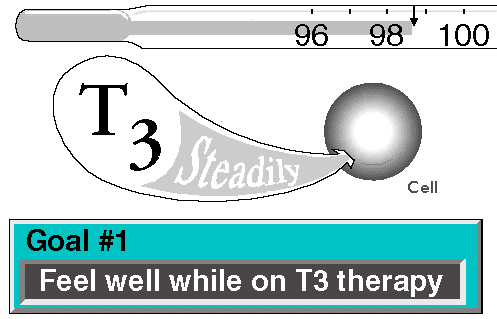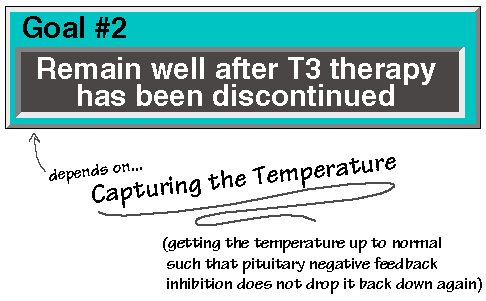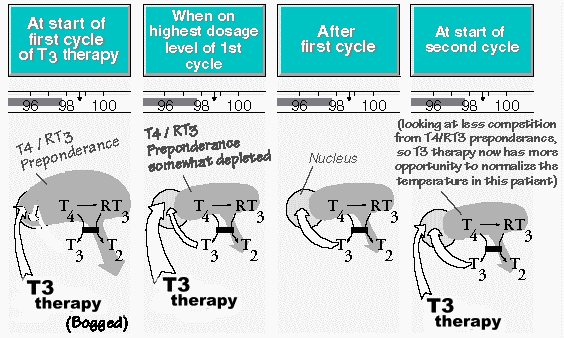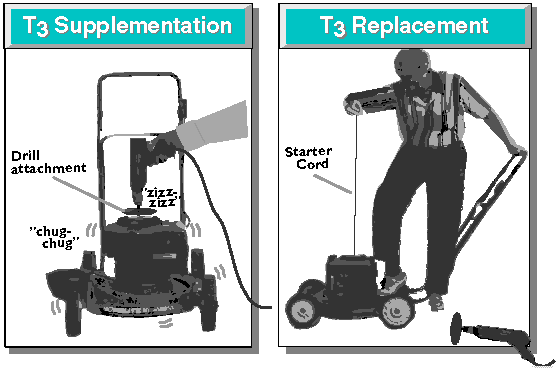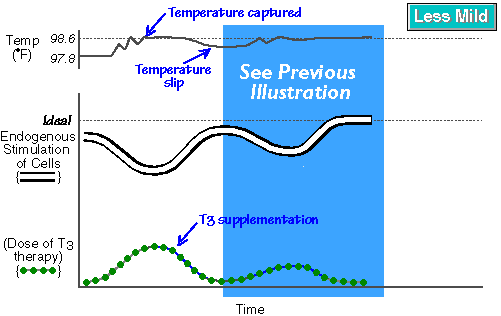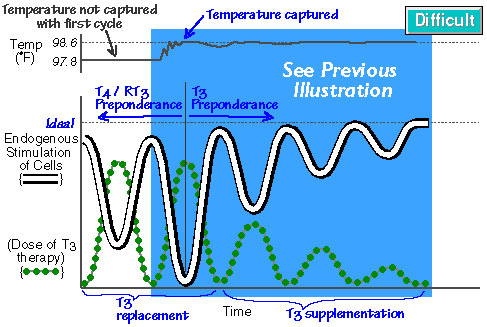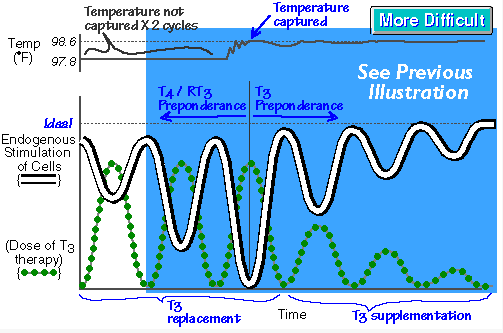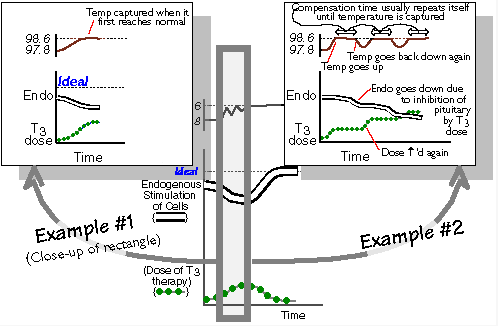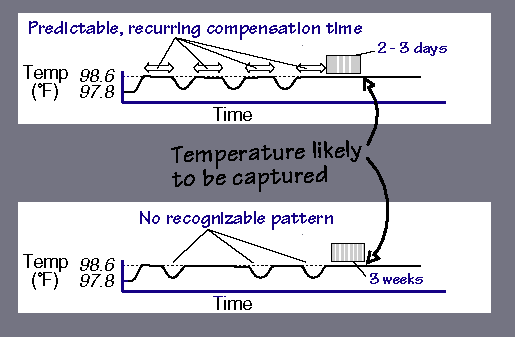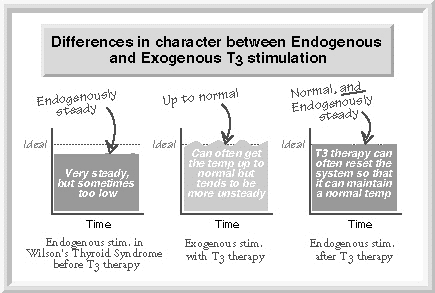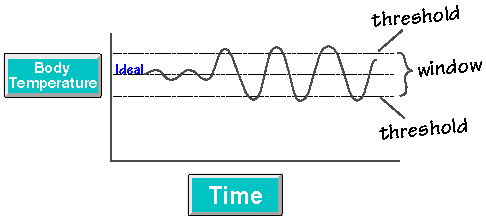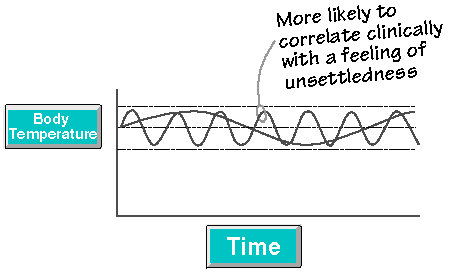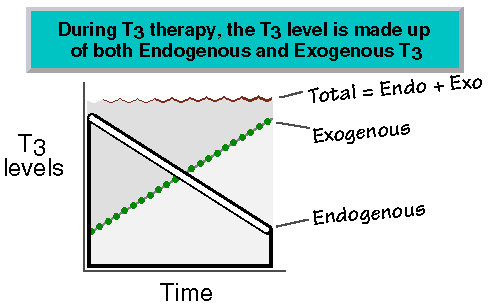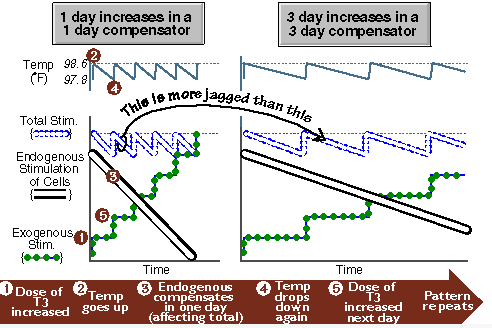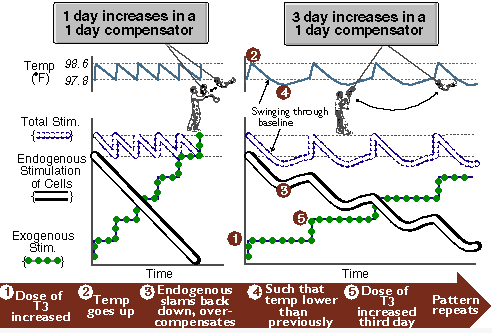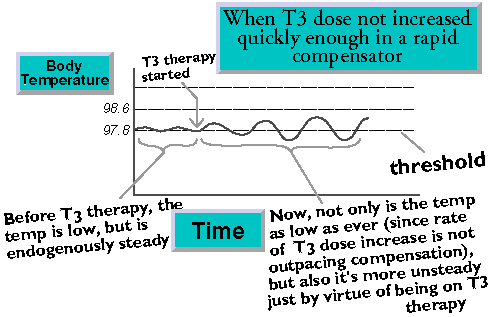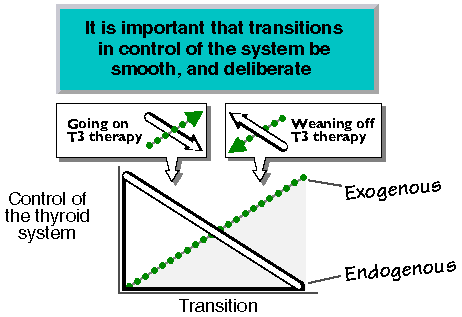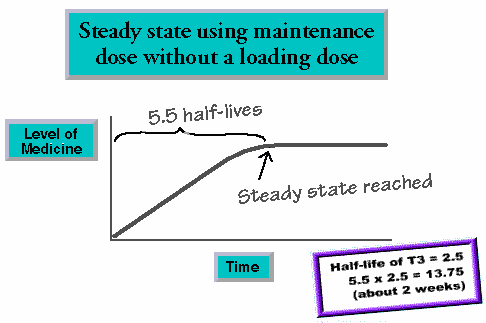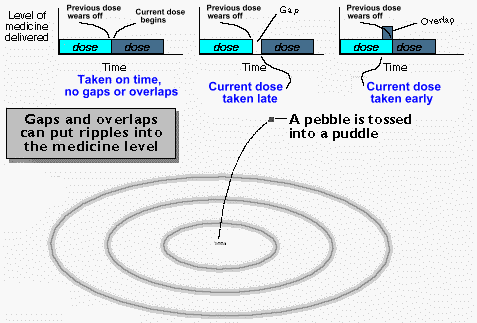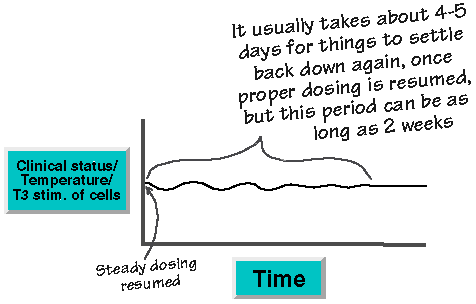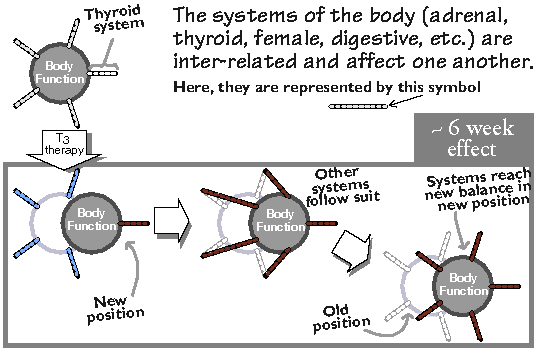Feeling well on T3 therapy has everything to do with the T3 stimulation being strong enough to get the temperature up to normal, and steady enough to be well tolerated. With T3, steadiness is everything.
The two goals of T3 therapy are:
1. To feel well while on T3 therapy.
2. To remain well after T3 therapy has been discontinued.
Accomplishing the first goal involves delivering sufficient T3 to break through the competition afforded by the T4/RT3 preponderance to generate a normal body temperature.
It also involves providing that T3 smoothly and steadily enough to generate smooth, steady, productive, and well-tolerated T3 stimulation of the cell.
With T3 levels, STEADINESS Is Everything. This cannot be over-emphasized.
Note: The fact that most of us have not noticed our breathing in the past 2 weeks is not a testament to the insignificance of the steadiness of pO2 levels. It is a testament to how well our bodies regulate our breathing to maintain such steady pO2 levels. If someone came up behind me, and clapped a hand over my nose and mouth unexpectedly, it would be only a matter of moments before I would be uncomfortable. And I would be uncomfortable long before my pO2 dropped all the way to zero. Likewise, because we have been administering T4-containing medicines for years and have not seen any great need to pay much attention to the steadiness of thyroid hormone levels is not a testament to the insignificance of the steadiness of T3 levels. It is a testament to how steadily our bodies convert T4 to provide for very steady levels of T3. The significance of the steadiness of T3 levels becomes obvious when one is providing the patient with T3 directly. And even though the half-life of T3 is 2.5 days, enough is gone within 3 hours of a missed dose that the patients can often notice the difference.
The lower the dose of exogenous T3 therapy the easier it is to keep the T3 level steady.
The second goal is accomplished by resetting the system, which is accomplished by “capturing” the temperature with T3 therapy.
The system is reset by giving T3.
Just giving T3? No, enough T3 must be given to get the patient’s body temperature up to normal.
Just up to normal? No, enough T3 so that the temperature goes up and stays up without dropping back down again.
I refer to this as “capturing” the body temperature.
This sometimes cannot be accomplished until T4 and RT3 levels have been depleted, or in other words, until the T4/RT3 preponderance has been removed.
This would explain why T4-containing medicines are not useful in bringing about the resetting phenomenon.
Personally, I feel that it is the depletion of the RT3 levels that is significant here. But depletion of RT3 levels comes about by the depletion of T4 levels.
The first and second goal are accomplished concurrently but are separate and distinct. For example, the second goal can be accomplished without the first goal being accomplished.
A person can be given enough T3 to capture her temperature, and reset her system without the T3 being administered steadily enough for her to feel well in the meantime.
A patient’s temperature of 97.8 is raised to 98.6 by gradually increasing her dose to, say, 45mcg BID. Yet, she notices no improvement in her symptoms even though her temperature is averaging normal. But as she weans off the T3 therapy, and her own steady endogenous supply of T3 comes back up well enough to maintain her now normal temperature, it becomes more and more steady.
As her T3 levels and body temperature becomes more and more steady around normal, her symptoms begin to subside, until they are resolved only after she is off the T3 therapy. This is not typical, but it does happen and does illustrate the point.
Another example (or precedent) of a “resetting” approach is the one that is commonly used in women who are having irregular menstrual cycles. Their female hormone blood tests may be in the normal range, but clinically, they’re having irregular menstrual bleeding. Frequently, it is not felt that there is something anatomically wrong with the patient’s ovaries or uterus, but that her female hormonal milieu has established itself in such a functional pattern as to be problematic. So, exogenous control is taken of the patient’s menstrual cycles with oral contraceptive pills, with the patient’s own endogenous hormonal production being suppressed, for a time. The patient is cycled for several months to artificially re-establish a pattern it is hoped her body can then maintain on its own once the ocp’s are discontinued.
Just as patients must frequently be cycled on ocp’s several times, so too do Wilson’s Temperature Syndrome sufferers frequently need to be cycled on and off T3 therapy more than once to fully re-establish the preferable thyroid hormonal milieu that corrects the symptoms, and that the patient’s own body can maintain naturally.
It sometimes takes more than one cycle of T3 therapy to even get the temperature up to normal (which is not necessarily the same as capturing the temperature). See below for explanation.
One explanation for this is that if a patient has a strong T4/RT3 preponderance, then the first cycle of T3 therapy (up to a dose of about 90 mcg’s BID) might not be able to break through the competition at the nuclear membrane receptor well enough to normalize the patient’s temperature; but only enough to deplete T4 and therefore RT3 levels somewhat, through negative feedback inhibition.
When the first cycle of T3 therapy is weaned and the patient’s own T4 production begins to come up again, with less RT3 around to compete against it, the T4 to T3 conversion pathway is more favored than previously (which favors a smaller T4/RT3 preponderance than previously).
At this point, if a second cycle is started, there is less of a T4/RT3 preponderance for the T3 to break through to stimulate the receptors, than there was prior to the first cycle. So the second cycle of T3 will have a better shot at normalizing the temperature, or at least of depleting the T4/RT3 preponderance more than was accomplished in the first cycle. And a third cycle (if needed) will often have a better opportunity than the second of getting more accomplished on lower levels of T3 therapy, and so on.

Some have wondered what is the defect that causes Wilson’s Temperature Syndrome .
I don’t feel there is a defect per se.
If there was a structural enzymatic defect, I don’t imagine that it could be corrected with T3 therapy in as quickly as 10 days in some cases.
I feel that Wilson’s Temperature Syndrome is a functional impairment because its onset and response to T3 therapy behave as such.
Here’s an analogy to illustrate the nature of Wilson’s Temperature Syndrome:
When you push a lawn mower into deep grass, it can become “overwhelmed” and begin to slow down. If you pull it out in time, it often speeds back up to normal on its own again. If you do not pull it out in time it can slow down further and stop completely.
Sometimes, the lawn mower has slowed down so much that it’s just on the verge of stopping when you pull it out. When this occurs, the machine can keep chugging along neither speeding up nor slowing down, and you can’t tell if it’s going to return to normal speed or if it’s going to stop completely. Sometimes, it can keep chugging along in this manner for a surprisingly long period of time. It seems to be just teetering on the edge, ready to lose its foothold and stall, or to gain the advantage and speed back up to normal. Here are three different and distinct modes of functioning: running normally, chugging along, and stopped. Yet in all three cases in our example, there is nothing mechanically wrong with the lawn mower. The blade, gas line, carburetor, and spark plug are all fine. It’s just that it’s a system in motion which has operational limits and an optimal operating speed. The machine can handle efficiently only so much grass per unit time.
Likewise, our bodies have operational limits and an optimal operating speed.
To further the analogy, please consider the explanation and picure below. If the lawnmower was chugging along, and there was some way you could give it a little push or advantage, you could help it to speed back up to normal (let’s imagine you had some sort of drill attachment you could use to speed up the top of the engine as it was spinning around). But if the engine stops, the drill attachment is not going to have enough power to start the engine, so you’re going to have to pull the starter cord. If the engine just stopped a few moments earlier, it may take only one pull of the cord. If it has been stopped since yesterday, it may take several. And if it has been in the garage since last season, it may take quite a few more.
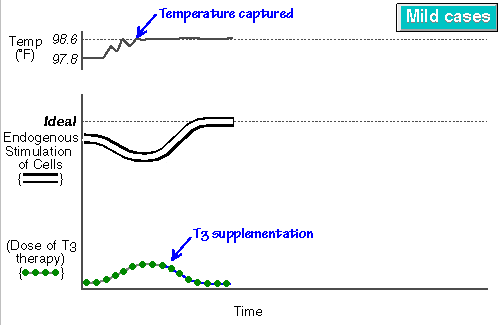
When the T3 therapy is weaned, the endogenous system comes back up again, often being able to maintain the normalized temperature on its own by virtue of a net gain in endogenous stimulation of the cell (resetting phenomenon).
Note: For T3 therapy, I recommend a T3 preparation that is compounded with a sustained release agent. It will be described more fully later (p112). But for now, suffice it to say that the starting dose is usually 7.5 mcg p.o. every 12 hours, and it is made in 7.5 mcg increments from 7.5 mcg up to about 90 mcg.
The benefits of T3 therapy are obtained by passing control of the thyroid system from endogenous control to exogenous control, and then back again (once through one cycle, or more than once through several).
Passing control of the thyroid system from endogenous control to exogenous control involves starting the patient on the starting dose, and increasing the dose by 7.5 mcg/dose/day if the patient is without complaints until the temperature remains 98.6 on average (which is almost always when the patients symptoms are most improved) or until the dose is up to about 90 mcg BID (in which case the T3 may be weaned off for a time, and another cycle can be started).
Once the patient’s temperature does go up to 98.6 under exogenous control on a certain dose of the T3, that dose is continued for a time. If while on that level of the medicine, the temperature drops back down again because of the body taking back control endogenously through negative feedback inhibition (I refer to this as compensation), exogenous control of the system is then regained and maintained by raising the dose to the next increment to bring the temperature back up to 98.6.
The patient may compensate to the T3 therapy again, and the exogenous dose can be increased again (up to about 90 mcg, see Note). As this process continues, less and less T3 is produced endogenously, and more and more is supplied exogenously.
The period of time from when a person’s temperature goes up to 98.6 with a 7.5 mcg increment, to the time it drops back down again, is what I refer to as a person’s compensation time.
Once the T3 dose is increased, such that the temperature is brought up to 98.6, it may be captured or it may drop back down again after a time (compensation time) due to negative feedback inhibition of the pituitary. Compensation times are predictable and average about 4 days.
If a person compensates to each of several increments of T3, the compensation time usually repeats itself. For example, a person with a 5-day compensation time (a 5-day compensator), might have her temperature go up on 30 mcg BID and stay averaging 98.6 only for it to go back down on the 5th day. Then, if it goes back up the next day when the dose is increased to 37.5 mcg BID, it may drop back down again 5 days later. This cycle will frequently repeat itself until the temperature doesn’t drop back down again.
Compensation times vary among patients. The compensation times of people who do compensate range from less than one day to about 3 weeks, with an average of about 4 days.
When a person’s compensation time (or three weeks if compensation time is not obvious) has passed by a couple of days and the temperature has not dropped back down again, I refer to the patient’s temperature as being captured (p75).
The benefit of a cycle has been pretty well obtained once the temperature has been captured, but it is often preferable to allow the patient to remain on that plateau of T3 therapy for a time before weaning.
This is the point at which control of the thyroid system has been completely passed from endogenous to exogenous control.
This does not necessarily mean, however, that a person’s thyroid system has been completely suppressed.
To review:
In less severe cases, or in the final cycle/cycles of therapy of more severe cases, T3 supplementation can often capture a patient’s temperature without completely suppressing the patient’s system.
In the beginning of more severe cases, one or more cycles of T3 replacement that completely suppresses the patient’s system may be necessary before the patient’s temperature can be captured.
It’s important to remember the difference between endogenous and exogenous T3 stimulation and it’s ideal to retain the best of both them.
When passing control back and forth between the endogenous system and the exogenous therapy, it is good to bear in mind their differences. The endogenous system is the indisputable world champion at generating steady T3 levels, but sometimes has trouble generating sufficient T3 stimulation.
On the other hand, the exogenous T3 therapy is excellent at providing sufficient T3 stimulation, but it is sometimes difficult to keep very steady.
The ideal situation of course is when the patient’s own system has been reset to provide sufficient T3 stimulation that is endogenously steady. And as discussed previously, this can often be accomplished by the passing control of the thyroid system from endogenous control to exogenous and back again, once or more than once.
It is important to keep the T3 levels steady since there are temperature thresholds above which or below which patients can experience temperature-mediated problems, even if there temperatures average normal.
The whole trick is to keep the T3 levels as Steady as possible during this process of passing control from endogenous to exogenous and back again.
One of the reasons for this is that patients can develop temperature-mediated problems when their temperatures are too high, or when they are too low (p18). So there is a range of temperatures (or window) within which people are less likely to experience temperature-mediated problems.
That temperature window is bounded on either side by temperature thresholds above or below which temperature-mediated problems (or side effects) become more likely.
So even if a temperature pattern averages about normal, if it is ranging so widely that it breaks through these thresholds, the patient may experience decreased benefits and some complaints.
Rapid changes in body temperature can leave patients with an unsettled feeling.
Another reason that steadiness is so important is that rapid changes in body temperature, in and of themselves, seem to be able to lead to decreased benefits and some complaints, even if the thresholds aren’t broken (p135).
Note: This is probably due to the fact that different enzymes change conformation, in response to temperature change, at different speeds; and because the reactions they catalyze have different rates. If the temperature swings through the optimal temperature too quickly, some of the quickly-responding enzymes and reactions may start becoming less efficient again just as some of the more slowly-responding enzymes and reactions are beginning to function well. But when the temperature transitions are more gradual, then more enzymes are able to function well at the same time, so that the patient is left with a more settled feeling.
When patients’ temperatures are fluctuating more rapidly (even if not beyond the thresholds), less time is spent by the system as a well-functioning unit, at the optimal temperature.
When patients’ temperatures are fluctuating rapidly, they are more likely to have an unsettled feeling, or to feel on edge.
For example, suppose you were a passenger in a car traveling 55 mph down a 4-lane highway (divided by a wide median, two lanes on either side). No other cars are in sight. As long as the car drives in one of the two lanes going your direction, and doesn’t drive off the road, you should be alright. But which do you think you would find more comfortable: for the car to swerve from edge to edge every 50 feet, or for it to drift from lane to lane every mile? If it were to swerve every 50 feet you wouldn’t be able to travel as far in the same amount of time (less benefit), and you’d likely not feel as well.
Thus, the height and steadiness of the T3 level is not only determined by the amount and administration of the exogenous T3, but also by the nature of a given patient’s endogenous response to it. One-day compensators can actually over-compensate and so need to be managed well to avoid problems.
Interestingly, how well T3 levels can be kept steady is not only a function of how the medicine is given, but also of how a patient’s body compensates to it.
About one out of ten people compensate to a 7.5 mcg increase in the T3 in less than one day!
These are one-day compensators.
They can compensate so quickly, they can even over-compensate, with their temperatures dropping lower than they were before treatment!
The following principles deserve close attention, since even though only about 10% of patients will be one-day compensators, if not managed well they can easily account for 50% of the problems in managing these patients.
Notice how much more jagged is the total curve for the one-day compensators. It is more difficult to keep the T3 level steady in one-day compensators, just by virtue of their being one-day compensators.
Generally speaking, the more rapidly patients compensate (the shorter their compensation times) the harder it is to keep their T3 levels steady.
Notice that if a rapid compensator is allowed to swing through the baseline temperature, like a child on a swing (by delaying dosage increases), greater amplitude of T3 unsteadiness often result.
Let’s say a father was pushing his daughter on a swing. If he stepped forward under her, such that just as she started to swing back he could catch her and push her up again, he could keep her within a narrow range of swing (see illustration above).
On the other hand, if he stepped backward, allowing her to swing all the way back before pushing her forward again, she would swing through a much broader range.
Likewise, if dosage increases are not made quickly (often) enough, when needed, the system can over-compensate (swinging through the baseline of total T3 stim.) resulting in a larger amplitude of T3 unsteadiness (especially if the delayed increases are made at times that resonate with the swings in the T3 level).
Consequently, body temperatures would swing through a broader range as well.
Swinging widely can be fun when one is on a swing set, but widely swinging T3 levels (T3 unsteadiness) can increase the chances of side effects.
If a person comes in and states that her temperature was lower the day after starting on the medicine than it was the day she started, that is your first clue she may be a one-day compensator.
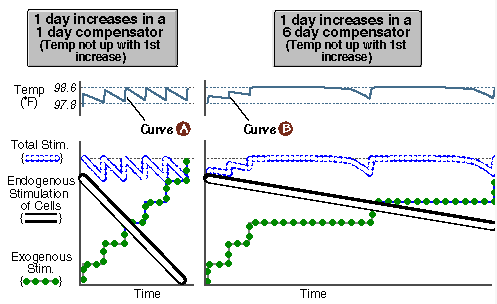
Notice how curve B is smoother than curve A, with less unsteadiness, and smaller amplitude. Slow compensators tolerate rapid increases better than fast compensators tolerate slow ones.
Slow compensators often tolerate T3 therapy being rapidly increased quite well.
They often enjoy temperatures that are quite steady with small ranges of displacement.
Slow compensators tolerate rapid increases better than fast compensators tolerate slow ones.
Since you can’t tell who are fast compensators and who are slow compensators by looking at them, I recommend gearing the T3 therapy towards the fast compensators by increasing the T3 dose by 7.5 mcg/dose/day in all patients. This is not to be careless, but to be careful, and deliberate.
Because I know if I increase the dose each day as needed to keep the fast compensators steady and in good shape, I’ll avoid a lot of problems and disappointment, and the slow compensators will likely tolerate it well and do fine as well.
Remember this is only when the T3 needs to be increased at all. When the temperature is 98.6, there is no need for the dosage to be increased.
Note: A and B above are important also because of the ripples that are created in the T3 level.
 Please see discussion that follows the picture below.
Please see discussion that follows the picture below.
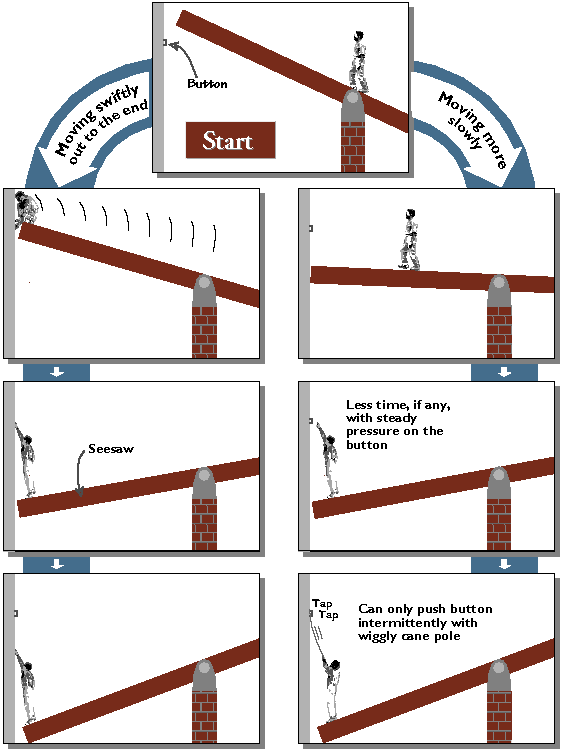
Suppose there was a little button 18 feet above the floor, on the wall of a room. And a young man has been told that if he can exert sufficient and continuous pressure on the button for a long enough period of time, he’ll have better than a 75% chance of having won an acceptance and $80,000 worth of scholarships to the university of his choice. Would that be worth a try? In the room are only a wiggly cane pole and a very large, very wide, and very heavy seesaw that is mounted to the floor. With the cane pole he can only push the button for a half-second or so at a time before the pole slips off the button. He realizes that he can reach the button if he climbs up and walks out on the seesaw. The seesaw is so heavy that when he walks out toward the end, it begins to lower only very slowly. He decides to back up and let the seesaw come up to its original position to get a fresh start. Would you recommend that he move out to the end swiftly, so that he can hold the button in for as long as possible before the seesaw lowers so much that he can no longer reach it? Or, would you recommend he move out to the end more slowly, and use the cane pole if he doesn’t reach the button with his hand in time? If he were going to try again, would you recommend he wait for the seesaw to come all the way back up to its original position and settle down, or not? For the analogy’s sake we’ll say that by moving slowly, his longest hold was only .75 seconds; but by moving swiftly, he was able to hold the button in for as long as 5 seconds, with the longest holds being when he let the seesaw settle down to get a fresh start.
The above analogy refers to the following concept:
The question behind a therapeutic trial of T3 therapy is: “How would a given patient feel with a normal and steady temperature, generated by a steady level of T3?”
But when one starts a patient on T3 therapy to increase the temperature, the level of endogenous T3 often drops in compensation (p85), as does the temperature [likened to the seesaw lowering]. As the endogenous portion of the T3 level becomes smaller, and the exogenous portion becomes larger, that alone will tend to make the T3 level more unsteady and less beneficial [likened to having to use the cane pole instead of his hand], even if the T3 doses are taken properly and on time. So to maximize the amount of time spent with the combination of a normal and steady temperature, and the chances of a successful therapeutic trial, it is often best to get the temperature up to normal, with endogenous T3 making up as great a proportion of the T3 level as possible. And one’s best chance at that is often to quickly increase the T3 therapy on top of a steady endogenous platform before that platform recedes very much [likened to moving swiftly out and holding in the button as long as possible before the seesaw lowers very much].
The above is is why a steady platform of endogenous T3 upon which to build is very valuable [likened to a fresh start]. And this is why it is very important to start each cycle, including the first cycle, with a stable T3 level (Q13). It is also important to make the most of a nice steady start by taking the medicine very much on time from the start (p103), so as to keep the T3 level as steady as possible.
It’s important to keep the T3 level steady from the start since steadying it down again, once unsteady, can take weeks. In a rapid compensator this requires increasing the T3 dose rapidly enough to get the patient’s temperature up to normal, rather than just enough to make the T3 level unsteady.
The whole trick to this therapy is to start the patient steady and to keep the patient steady on the medicine.
If the patient’s T3 levels do get unsteady on the T3 therapy it may take several weeks to “recapture” that steadiness (p101), which may involve having to wean the patient off the treatment for a time to get a fresh start, and then starting it back up again.
If you don’t increase fast compensators quickly enough their temperatures will go back down when they compensate, and be as low as they ever were. But then, not only will their temperatures be too low but also they will be unsteady (because the higher the dose of exogenous T3 the harder it is to keep the T3 level steady), and they may feel worse than when they started.
If you’re going to give people T3 therapy, then you need to give them enough to get their temperature close to normal.
Otherwise, you’re not giving them enough to improve their temperature but only enough to make their T3 levels unsteady which increases their chances of side effects.
You and the patient may choose to increase the T3 more slowly than each day, which in some cases may work out quite well. But if you do, you must accept the 10% risk that this patient is a one-day compensator, and may not do very well. In which case, at the first sign of side effects, those side effects may be addressed (p129) and the patient may be weaned off the T3 for a couple of days to let the T3 level settle back down. At this point it may need to be decided to increase the medicine each day or not at all.
So T3 therapy (especially in those 10% of patients who are fast compensators) is a little like crossing a street that has a gutter filled with water. If you want to cross without getting wet then you may want to run fast enough and jump high enough to clear the water, or not jump at all.
Another good reason to increase the T3 medicine every day, if needed, is that in more severe cases it may take a few cycles before the patient notices much improvement. Even if the dosage is increased every day, going on and off one cycle could easily take over 4 weeks. Some cases are such that, at this rate, it will be over 3 months before the patient feels much improvement! It is a discouraging prospect at the outset, but increasing the dose every 3 days, could lengthen that time to 6 months. With that possibility looming it would seem unprofitable to dillydally.
Either the endogenous system should be in control or the exogenous therapy should be in control. Control should be passed smoothly, deliberately, and completely from one to the other. Backtracking in the middle of going on or off a cycle of T3 therapy can lead to difficulties and confusion.
To avoid the pitfalls of this approach, one should make deliberate (not tentative), and gradual (not necessarily slow, but they should be gradual) one-way transitions between endogenous control and exogenous control.
As in football: “Either you carry the ball or I’ll carry the ball but let’s not fumble it between each other.”
And, as in relay races: “We pass the baton, We don’t throw it.”
Here is an example of the difficulties presented by backtracking:
A patient has a temperature of 98.6F on 60 mcg’s twice a day of T3 therapy. Her doctor decides to wean her off the T3 to see her temperature remains normal as she weans, or if it doesn’t, to see if she can get her temp to 98.6F on less medicine during the next cycle. While the patient is weaning off the T3, her temperature starts to slip a little, so she and her doctor decide that she should go not wean off any more but go back up to the 60 mcg’s BID she was on. To their surprise and confusion, her temperature doesn’t go back up to normal when she gets to 60 mcg’s BID! This can happen and is probably due to T3 unsteadiness due to the changing T3 doses. If the patient had gradually weaned all the way off and remained off the T3 for a couple of days to allow her own T3 levels to steady down, and then started the next cycle, she might have well gotten her temperature to 98.6 on only 37.5 mcg’s BID. This may not make complete sense to you now, but it will after you read the rest of this manual. I just wanted to give you an idea of what sort of unexpected difficulties one can run into by deviating from the protocol.
It is more effective to continue increasing the dose of T3 until the patient’s temperature is normal (Q8), rather than to leave the patient on a smaller dose of the T3 for longer periods of time. This is especially true in more severe cases that require several cycles of therapy to be corrected. If one “dillydallies” in such a case, a patient could be treated for 6 months with very little improvement, and very little being accomplished.
Extra Credit:
Once a patient compensates to a dose of T3 very little more will occur over time.
Some may hope that if the T3 lowers the T4, and that lowers the RT3, then there might be less inhibition of the conversion of T4 to T3, more T3 stimulating the cell, more suppression of T4, less RT3, less impaired conversion, and so on. Clinical observations do not support this hope. Theory and clinical observation suggest that the above mentioned effect has already occurred during the time it takes a person to compensate (e.g.-within the 3 day compensation time in a 3-day compensator). Remember, the majority of T4 is converted to RT3 which suggests the body is quicker to produce RT3 from T4 than it is T3. Also, the half-life of RT3 is on the order of hours, not days. [Occasionally, however, a temperature that is already normal sometimes begins to increase with no further increases in dosage, requiring the dosage to be decreased (and in this way a few patients are automatically weaned as their own systems come back up)].
To reach steady state without a loading dose it will take 5.5 half-lives of the medicine being given in a maintenance dose. (Here we’re talking about a pharmacologic principle to illustrate a point. We are ignoring for the moment endogenous compensation and its effects on the T3 level in the specific case of T3 therapy.)
It is rather surprising to see how important the steadiness of T3 levels is. If there is anything that has become apparent in this work, it is that the steadiness of T3 levels is more delicate and significant than it seems we have previously imagined.
Consider this: There is a pharmacologic formula that states that one can calculate how long it will take to reach steady state when using a maintenance dose of a medicine without a loading dose, by multiplying the medicine’s half-life by 5.5.
The half-life of T3 is 2.5 days.
2.5 days * 5.5 = 13.75 days or about 2 weeks.
This means that if in the first two weeks of treatment (forgetting for the moment about compensation) the patient misses a dose or two, it will take a little longer to reach steady state.
That is, a patient’s T3 level of today has something to do with doses taken about 2 weeks ago.
But remember steadiness is nothing more than a patient’s level per unit time.
So if a person’s T3 level can be affected by the dosing of the past two weeks, so can the person’s T3 level steadiness.
Thus,if people miss a dose, completely or by a period of time, it puts blips, depressions, holes, gaps, or ripples into their T3 levels that can persist for 2 weeks.
If it patient is taking a sustained-release medicine that is delivered at a steady rate continuously over 12 hours then the level will be steadier if the medicine is taken on time so that there are no gaps or overlaps.
This is much like dropping a pebble into a puddle. The tiny stone touches only a small part of the water itself, but the ripple it causes spreads in all directions, all the way out to the limits of the puddle. Likewise, even though the half-life of one dose is 2.5 days, it’s influence on the next dose, and the next dose, and so on can last for up to two weeks.
So you can see, if you miss every other dose by 20 minutes here, and 30 minutes there, pretty soon you’ll have nothing but ripples. In addition, if one ripple happens to coincide with an upswing in the T3 level due to another ripple of unsteadiness, the ripples can become superimposed, which can cause higher peaks and lower troughs, and in this way things can get unsteady, with a person’s T3 level “resonating” itself out of control.
A patient can’t correctly say in her mind, “Well I wasn’t taking the medicine very well on time before, but that influence is gone now because I have been taking it on time for the past two days.”
Once the T3 level becomes unsteady, due to not taking the T3 very well on time, it usually takes 4-5 day’s to settle down again when proper dosing is resumed. So it’s best to keep the T3 level steady from the start, especially since improvements can be lost before any side effects are experienced.
Evidence for this settling effect can be seen clinically. Suppose a person has a temperature averaging 98.6 on, for example, 45 mcg p.o. BID and is feeling very well. And if that person stopped taking his medicine very well on time, and noticed some of his symptoms returning, and then started taking his medicine on time again, it would usually take about 4 – 5 days for his T3 levels to steady back down, and for his symptoms to improve again. This settling effect can often be seen in the steadying of his temperature as well. Sometimes however, the steadying takes up to 2 weeks (not usually longer).
So you can see why it is so important to start patients steady and to keep them steady from the start, because if things get unsteady, they can stay unsteady for a couple of weeks.
Note: There are a few management techniques that can be employed in cases such as the one mentioned above, to steady things down hopefully a little more quickly, such as a T4 test dose (p129), and/or weaning the patient off the T3 and then restarting it; but it’s much better not to have to implement those things in the first place (especially the re-cycling because that can take a few weeks).
Another reason to start steady and keep steady is that ripples can cause a loss of improvement before they ever cause side effects, so it’s best to hold the T3 therapy as steady as possible from the start, because improvement can be lost with little or no warning.
The 2-week settling effect is another reason not to dillydally in getting patients to the dose they might need, but to move the patients along as deliberately as possible, because the sooner the patients can be brought to the right dose, the sooner the 2-week stabilizing effect can begin.
This is one reason also, that I don’t recommend making a lot of changes in a patient’s T3 dosage because of unrelated influences. For example, a patient has been doing well on 30 mcg p.o. BID for several weeks and gets a little fever because of a virus. I would recommend that the patient get through the several-day virus the same way he usually would with no changes in T3, because I don’t want to make 2-week changes, for 3-day vicissitudes. If I change the dose for a few days and then change it back again, it may take two weeks to again steady down as well.
This same principle applies to women doing well on a certain dose, whose temperatures go a little higher than 98.6 the 2 or 3 days prior to their period, or in the middle of the month at ovulation.
Changes in body function brought about by T3 can then result in a recalibration of other body systems, which probably helps the body’s function to remain improved after the treatment is discontinued.
There is another settling effect worth mentioning. This effect is seen when a patient seems to feel better and better on the same dose even for up to about 6 weeks later, or more. This is a little different than the reproducible and recognizable 2-week stabilization effect mentioned above. I feel this is not so much related to the pharmacodynamics of the T3 therapy, so much as it is in the results of the T3 therapy, especially with respect to other body systems.
It seems that once the thyroid system is being held in a favorable position, then the other systems can follow suit and function better also.
I feel that these other systems falling into a new balance of functioning in relation to the thyroid system and each other, is part of what solidifies the inertia of the new position (or mode) of functioning that helps the body’s function to remain improved even after the treatment has been discontinued.
Note: In the ropes and rings diagram above, we’ve pulled on the “Thyroid” rope. The thyroid rope is strong and it’s simple because it’s just T3 to get the temperature normal. It’s great when T3 does the job because the fewer the variables the easier the management. Nevertheless, some doctors find it helpful, and in some cases necessary, to pull on the “Adrenal” rope as well. Adrenal glandulars, DHEA, Florinef, and small physiologic doses of hydrocortisone (as per Dr. Jefferies’ work, “Safe Uses of Cortisol”), are some of the adrenal support measures doctors are using. (See Same Principles Applied Differently on page 205). The “Female” rope can be addressed as well as in Dr. Lee’s work, “What Your Doctor May Not Tell You About Menopause,” where he advocates the use of progesterone cream.
To summarize, the character of the process of resetting patients’ thyroid systems, and therefore their metabolisms, is like moving the position of a croquet ball on a sandy beach. The thyroid system has a great deal of inertia, and once it has settled into a certain position it tends to stay functioning in that same way. Imagine a croquet ball that has been sitting in the moist sand for a time. It has become embedded there. It takes a little effort to dislodge it from its position, but once it is free, it is relatively easy to roll along the sand. However, it’s position is more easily influenced by the wind and other forces as it rolls along the top of the sand, than it was when it was embedded. However, once you’ve let it roll to a new position, and held it there for a time, it will again begin to settle in and get embedded. Once it has become embedded in a new position it will have a tendency to stay there.
This is very similar to the way the thyroid system behaves. It may take some decisive and deliberate effort to begin to reset a person’s system, but once her temperature has been captured, it is frequently relatively easy to cycle her with diminishing cycles of T3 until her temperature is normal off medicine. During the cycling process, however, her temperature and symptoms may be more easily influenced by changes in sleeping habits or work habits, traveling through time zones, emotional stresses, and timing of doses. This is why it is best during the cycling process to take great care to keep everything as steady as possible while her system is being reset. Once the patient’s symptoms are completely corrected it is sometimes preferable to leave the patient on the same dose of T3 for several weeks after the temperature has been captured to give her system more time to “settle in” to its new mode of functioning before weaning the T3. Once off treatment, the patient might consider not making any drastic changes in her life for 3 – 6 months, to allow further embedding, to decrease the chance of relapse. Once settled in, the patient should again be less influenced by the vicissitudes of daily life.
When patients are treated with a cycle of T3 therapy, they often retain what symptomatic improvement they do get from that cycle, even if it is not complete. For example, a patient with a percentage index of 40% [patient feels 40% of what the patient imagines a normal person to feel like (c5)] may improve to 60% with the first cycle. That improvement to 60% often persists indefinitely, even if a second cycle is not started right away. With another cycle that patient may improve to 80%, and with the next cycle to 100%. There is a possibility, however, of factors pushing progress backward: if such a patient has progressed to a percentage index of 80%, and undergoes some stress, then his/her percentage index might slip back a step to 60%.

